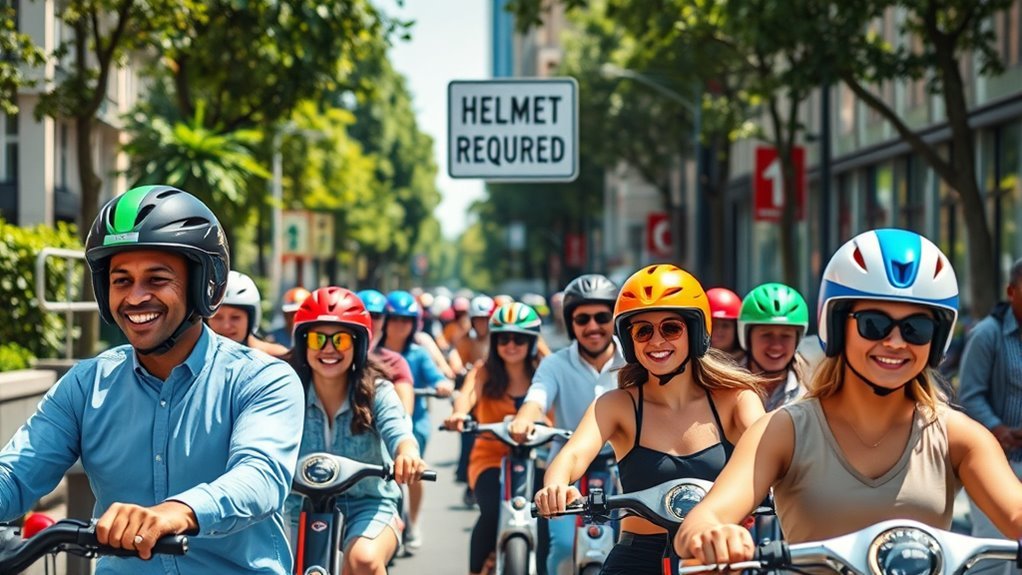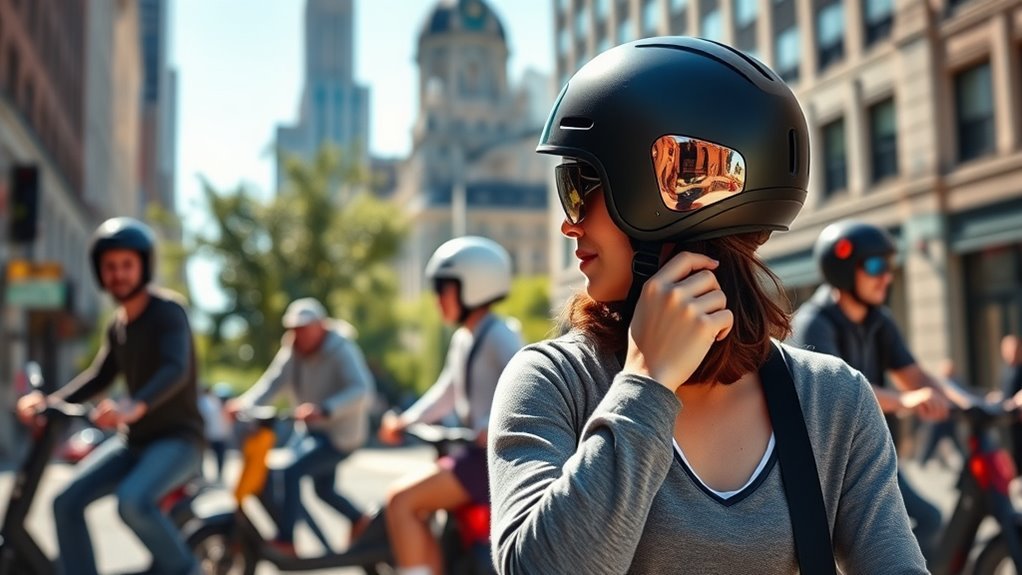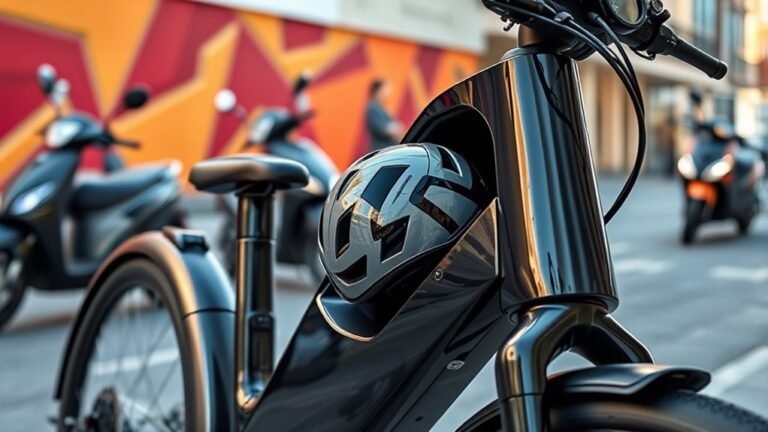Helmet Laws for E-Scooter Riders
Helmet laws for e-scooter riders vary considerably across regions. In countries like Australia, helmet use is mandatory, while many U.S. areas leave it optional, leading to different compliance rates. Studies show helmets can reduce head injuries by up to 70%, which supports arguments for mandatory laws. However, such regulations may deter casual riders, affecting overall usage. Understanding these dynamics can illuminate how helmet laws influence safety and rider behavior, revealing important insights about urban mobility.
The Rise of E-Scooter Popularity

As urban areas become increasingly congested, e-scooters have surged in popularity, offering a convenient alternative for short-distance travel. You’ll find that e-scooter convenience greatly enhances urban mobility, allowing for quick and efficient transportation in densely populated regions. Studies indicate that e-scooters can reduce traffic congestion and lower carbon emissions, appealing to environmentally conscious riders. Additionally, their affordability and accessibility make them an attractive option for many individuals seeking freedom from traditional commuting methods. With a growing network of designated lanes and parking areas, cities are adapting to accommodate this mode of transport. As more people embrace e-scooters, they’re reshaping urban landscapes, promoting a shift towards sustainable and flexible transportation solutions that empower you to navigate your surroundings with ease.
Understanding Helmet Safety Benefits

With the rise in e-scooter usage, safety concerns have become more pronounced, particularly regarding head injuries. Wearing a helmet can greatly enhance your safety while riding. Studies indicate that helmets can reduce the risk of head injuries by up to 70%, showcasing their effectiveness in injury prevention.
Here’s a summary of helmet safety benefits:
| Benefit | Evidence | Impact on Riders |
|---|---|---|
| Reduced Head Injuries | 70% reduction in severe injuries | Safer riding experience |
| Lower Healthcare Costs | Decreased medical expenses | Financial savings |
| Increased Awareness | Promotes safer riding habits | Better community safety |
| Legal Compliance | Fulfills laws in many regions | Avoids penalties |
| Enhanced Visibility | Bright colors improve visibility | Fewer accidents |
Embracing helmet safety is a vital step towards a more secure and enjoyable ride.
Current Helmet Laws Around the World

While the benefits of wearing helmets are widely recognized, the laws governing their use for e-scooter riders vary considerably across the globe. In some countries, like Australia and Germany, helmet use is mandatory, reflecting stringent global regulations aimed at enhancing rider safety. Conversely, many regions, including parts of the United States, allow riders the freedom to choose whether or not to wear a helmet, resulting in significant regional differences. This disparity often sparks debate about balancing personal freedom with public safety. Understanding these laws is vital, as they can impact your riding experience and responsibilities. As e-scooter popularity grows, it’s important to stay informed about the legal landscape in your area to guarantee compliance and promote safety.
Arguments for Mandatory Helmet Use
When considering mandatory helmet use for e-scooter riders, safety statistics consistently highlight the protective benefits helmets provide in reducing head injuries during accidents. Additionally, there’s a growing legal responsibility that riders must acknowledge, as non-compliance with helmet laws can lead to penalties. Understanding these factors is essential for evaluating the necessity of helmet regulations.
Safety Statistics Support Helmets
Helmet use among e-scooter riders is a critical factor in reducing the severity of injuries sustained during accidents. Studies show that helmets can decrease the risk of head injuries by up to 85%, emphasizing their effectiveness in injury prevention. Despite the desire for personal freedom, the data is clear: wearing a helmet considerably lowers the likelihood of severe outcomes in crashes. Whether it’s a minor fall or a high-speed collision, the protection offered by a helmet can be the difference between a minor injury and a life-altering event. By embracing helmet use, you’re not only prioritizing your safety but also contributing to a culture of responsible riding that values health and well-being. Ultimately, freedom includes making choices that safeguard your future.
Legal Responsibility for Riders
Mandatory helmet laws for e-scooter riders stem not only from safety concerns but also from the legal responsibility riders have for their own well-being and that of others. When you ride without a helmet, you’re exposing yourself to potential legal implications, especially if an accident occurs. Should you suffer an injury, courts may scrutinize your decision to forgo a helmet, affecting liability and compensation claims. This highlights the importance of rider accountability; wearing a helmet isn’t just a personal choice, but a commitment to safety. By adhering to helmet laws, you’re not only protecting yourself but also reinforcing a culture of responsibility that can lead to safer riding environments for everyone. Freedom comes with responsibility, and helmets are an essential part of that equation.
Arguments Against Helmet Mandates
While some argue that helmet mandates enhance safety for e-scooter riders, evidence suggests that such laws may deter usage and limit mobility. Here are three key arguments against helmet mandates:
- Rider Autonomy: Many riders value their freedom to choose whether or not to wear a helmet, and mandates can undermine this personal decision-making.
- Public Perception: Helmet laws might lead the public to view e-scooters as inherently dangerous, potentially discouraging new users from trying them.
- Impact on Usage: Research indicates that when helmets are required, it can result in fewer riders overall, which contradicts the goal of promoting alternative transportation options.
In essence, prioritizing rider autonomy may foster a more inclusive and vibrant e-scooter culture.
The Impact of Helmet Laws on E-Scooter Usage
Helmet laws can greatly affect e-scooter usage by influencing rider safety and compliance rates. Studies suggest that while such laws may enhance safety awareness, they can also deter potential riders due to perceived inconvenience. Analyzing trends in usage rates before and after helmet mandates reveals important insights into rider behavior and overall adoption of e-scooters.
Safety and Compliance
E-scooter riders face a complex landscape of safety regulations, with helmet laws playing an essential role in shaping their riding behavior. These laws aim to enhance safety, but they also influence your experience on the road. Here are three key impacts of helmet laws on e-scooter usage:
- Increased Safety: Wearing helmets with advanced helmet technology can notably reduce head injuries in crashes.
- Rider Education: Compliance with helmet laws encourages riders to educate themselves about safe riding practices.
- Perception of Freedom: While some see helmet laws as restrictive, they can promote a culture of safety that ultimately supports more widespread e-scooter use.
Balancing safety and freedom is vital for fostering responsible e-scooter environments.
Rider Behavior Changes
The implementation of helmet laws has a profound impact on rider behavior, often shaping how individuals approach e-scooter use. When you know a law mandates helmet usage, it can influence your rider psychology, making you more conscious of safety while riding. This awareness can lead to behavior adaptation, where you might take fewer risks or choose safer routes. Studies suggest that helmet laws can create a sense of accountability, leading riders to be more mindful of their surroundings. However, some riders may resist these regulations, viewing them as limitations on their freedom. Ultimately, the presence of helmet laws can foster a culture of safety, encouraging responsible riding practices while still allowing individuals to enjoy the thrill of e-scooter travel.
Usage Rate Trends
In many regions, the introduction of helmet laws has led to noticeable fluctuations in e-scooter usage rates. These laws can impact various factors, influencing rider demographics and usage patterns. Here are three key trends observed:
- Decrease in Casual Riders: Casual users, particularly younger individuals, often feel discouraged by mandatory helmet rules.
- Increase in Safety-Conscious Riders: Conversely, those prioritizing safety may be more inclined to use e-scooters when helmets are required.
- Shift in Usage Times: Peak usage times may change, with fewer rides during peak hours as riders reconsider their travel choices.
Case Studies: Cities With Helmet Regulations
While many cities have embraced the rise of e-scooters, their approach to helmet regulations varies considerably. Helmet regulation case studies reveal distinct strategies and city implementation challenges that affect rider safety and user compliance. Here’s a brief overview of some cities:
| City | Helmet Regulation | Compliance Rate |
|---|---|---|
| San Francisco | Mandatory | 30% |
| Austin | Recommended | 50% |
| Paris | Optional | 60% |
| Berlin | Mandatory | 45% |
| Toronto | No regulation | N/A |
These statistics highlight how regulatory frameworks influence safety behaviors. As you navigate these cities, understanding the local helmet laws can empower you to make informed choices about your safety while enjoying the freedom e-scooters provide.
Future Considerations for E-Scooter Safety Policies
As cities continue to adapt to the growing popularity of e-scooters, the need for effective safety policies becomes increasingly critical. Addressing regulatory challenges and developing robust enforcement strategies can help guarantee rider safety while maintaining the freedom e-scooter users cherish. Here are three future considerations for improving e-scooter safety policies:
- Standardized Helmet Laws: Implement consistent helmet requirements across jurisdictions to reduce confusion and increase compliance.
- Data-Driven Regulations: Use accident data to inform policy adjustments, targeting high-risk areas and times.
- Public Awareness Campaigns: Promote safety education through campaigns that emphasize responsible riding behaviors and the benefits of helmet use.
Frequently Asked Questions
Are There Specific Helmet Standards E-Scooter Riders Should Look For?
Yes, there are specific helmet standards e-scooter riders should look for. You should check for helmet certifications like CPSC (Consumer Product Safety Commission) or Snell, which guarantee that the helmet meets safety requirements. Additionally, look for safety ratings from organizations like the Virginia Tech Helmet Lab, which provide evidence-based assessments of impact protection. Choosing a certified helmet not only guarantees your safety but also enhances your freedom to ride confidently.
Can I Wear a Bicycle Helmet While Riding an E-Scooter?
You can definitely wear a bicycle helmet while riding an e-scooter. It’s a smart choice, as bicycle helmet safety standards are generally effective for protecting your head. However, make sure it meets e-scooter regulations in your area, as some places have specific requirements. Wearing an appropriate helmet allows you the freedom to ride confidently, knowing you’re taking necessary precautions for safety while enjoying your ride on two wheels.
What Penalties Exist for Riding Without a Helmet?
If you ride without a helmet, you could face fines and penalties that vary by location. These legal consequences may include monetary fines, points on your driving record, or even restrictions on riding in certain areas. It’s crucial to understand that these regulations aim to promote safety, but they can also impact your freedom to ride. Always check local laws to stay informed and avoid unnecessary penalties while enjoying your ride.
Are There Exemptions to Helmet Laws for E-Scooter Riders?
Yes, there can be exemptions to helmet laws for e-scooter riders, but they often depend on specific exemption criteria and age restrictions. For example, some jurisdictions may allow riders over a certain age, like 18, to ride without a helmet, promoting personal freedom and responsibility. It’s crucial to check local laws, as these exemptions vary widely, reflecting different approaches to balancing safety and individual choice in scooter usage.
How Do I Properly Fit a Helmet for E-Scooter Use?
To properly fit a helmet for e-scooter use, start by checking helmet sizing; measure your head circumference just above your ears. Adjust the straps to guarantee the helmet sits snugly, about an inch above your eyebrows. The chin strap should be tight but comfortable, allowing for a one-finger gap. Make adjustments so the helmet doesn’t move when you shake your head. Proper fitting enhances safety while allowing you the freedom to ride confidently.






